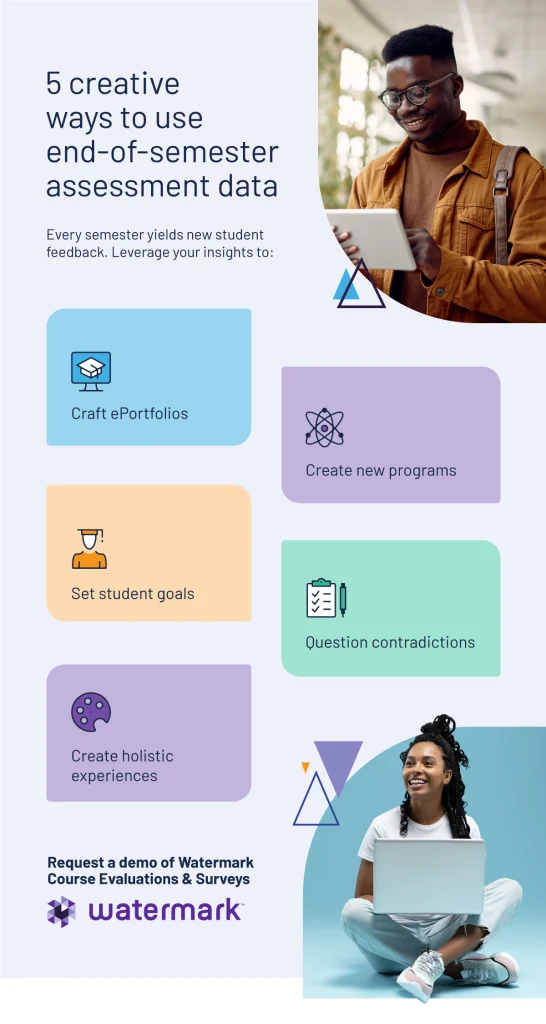



It’s common for higher education institutions to receive an influx of data at the end of every semester, but if you don’t know what to do with it, you could get stuck spinning your wheels.
Thankfully, you can use student feedback and other end-of-semester data in many creative ways to foster continuous improvement. Read on to learn how.
Higher education institutions use end-of-semester evaluations and surveys to identify problem spots and strengths in their institutions. Recording and analyzing student data drives institutional changes. Several colleges and universities use student feedback to see if they’re meeting their student’s needs. They may be researching how many students use various campus resources, evaluating the efficiency of an instructor, or debating the success and engagement of a new program.
Knowing how to use end-of-semester data will enable you to reach institutional goals, drive initiatives, and create exceptional learning experiences for your students. By encouraging your students to relay their experiences, you can gain valuable insight into where they need more assistance, what they would like to see more of, and what isn’t working for your institution.

Online portfolios can be a collection of video files, images, writing samples, screenshots, and more. Your students can compose them for the end of the semester to showcase their work and highlight their experiences. Using ePortfolios in end-of-semester assessments encourages students to get creative with how they show the knowledge they’ve obtained. These portfolios may be a combination of the most absorbed information or their favorite assignments, giving instructors an idea of what students appreciate and remember most.
Obtaining end-of-semester data in the form of ePortfolios gives you, your students, and your educators an opportunity to evaluate a new set of data. You’ll recognize where students are excelling and what’s engaging them in their courses. If many students are reflecting on certain parts of your campus or one assignment is particularly engaging, you’ll have an idea of what your institution has been doing well and what areas aren’t getting enough student recognition.
Students who feel a sense of community in their schools tend to perform better and have a more fulfilling learning experience. You can use student evaluations to establish the precedent for new programs or resources. It’s possible that many students will be looking for similar experiences, such as a new group to join, community service opportunities, or school events that encourage them to connect with their peers.
The more information you receive, the more you can do with it. Use your end-of-semester data to improve student success. Instead of creating long files that you pile up in forgotten cabinets or computer documents, use your information to make digital student profiles. After completing their evaluations, students could sit down and discuss actionable steps they can take to perform better in the upcoming years with their advisors. Student success teams can access student grades and discuss the trends they see, help students form goals, and encourage them to take advantage of campus resources.
Additionally, these student profiles can help your faculty and staff practice intervention strategies with struggling at-risk students. Offering personal counsel and encouraging students to talk with advisors or instructors they feel a connection with may motivate them to keep going and finish their studies.
Student feedback and end-of-semester evaluations are a great place to start tracking trends and identifying how to overcome challenges to set a new precedent.
For instance, if you notice a student who performs very well is beginning to slip in their performance, missing classes, or neglecting to turn in assignments, it’s likely this student is struggling in some aspect or another. While they may be going through a personal matter, there could also be institutional problems discouraging them. Your evaluations are a place to spot patterns. If other students are exhibiting similar behavior, maybe there’s a flaw in their shared program.
Additionally, if you notice that many programs have exceptional graduation rates or high grades and test scores, while others see dropouts increasing every semester, you should evaluate those programs. Determine if all of your programs are receiving the same funding and opportunities. If you don’t have enough professors to run a department effectively, your students may feel overwhelmed and not know how to access additional resources.
Each student is different and will bring their own experiences and perspectives to your institution. Approaching education as a one-size-fits-all endeavor isn’t effective for your students.
Rather than setting one goal for every student, you should break down the steps it takes to get there and craft a personalized path to success for each student. Course evaluation results that indicate your students feel isolated or lonely, lack support, or have minimal connections with their peers likely mean it’s time to create new success pathways.
Watermark Course Evaluations & Surveys helps you collect this information from your students at scale. Gain invaluable insights from the data, track student and program trends over time, and illuminate what improvements should be made.

At Watermark, we use data to create solutions that empower better learning. We’ve spent over 20 years crafting software solutions your institution can use to create personalized learning experiences for your students.
Use Watermark Course Evaluations & Surveys to customize your student evaluations and drive institution initiatives. With our software, you’ll eliminate the need for manual reporting — and the loose papers that can get lost or misplaced. Request a demo of Watermark Course Evaluations & Surveys and start using student feedback to improve your institution today.





























































































































































































































































































































































































